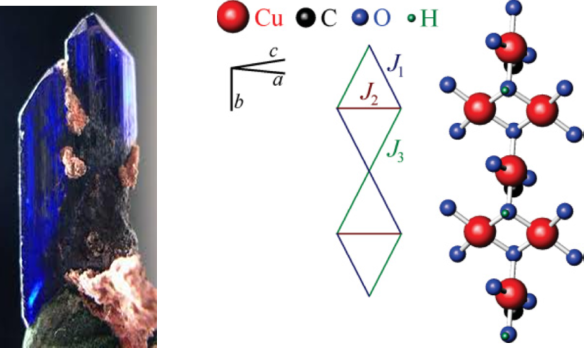I'm blue da-ba-di da-ba dah – The natural mineral, Azurite
What does it look like?

What is it?
Azurite is a beautiful blue natural mineral found in mines across the world. Its main use is as a blue pigment for paints, and chances are that many of the Renaissance art work that you have seen will have some azure blue colours.
More recently however, azurite has been studied as low dimensional quantum magnet. So while the crystal structure is clearly 3D, the magnetic interactions between Cu-ions occur in only one direction. Thus we can call azurite a prime example of a 1D distorted diamond chain magnet. Scientists are investigating materials such as these, to better understand the magnetism in a relatively simplified model. Once we can fully understand the magnetic interactions in 1D, we can extend our models to involve more complex interactions in 2D and 3D. From there, we can hope to understand better such materials as high Tc superconductors, where the interplay between magnetism and superconductivity is highly correlated.
Where did the structure come from?
The structure has recently been presented1 and shows that the space group is in fact the low symmetry group P21 rather than P21/c as previously thought. The discrepancy comes about from the measurement techniques used. While X-ray scattering could accurately place the heavier atoms, it could not easily predict where the hydrogen atoms in the structure were. Only with neutron scattering could a more accurate hydrogen atom position be found. The breakthrough however came by using single-crystal diffraction on a 4-circle diffractometer (D10 at the ILL), which clearly showed reflections that were forbidden from the P21/c space group.
References:
1 K.C. Rule et al., Magnetic and crystal structure of azurite Cu3(CO3)2(OH)2 as determined by neutron diffraction, Physical Review B 83, 104401 (2011).






